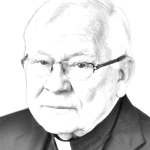During this challenging winter, I often returned to the final lines of Shelley’s “Ode to the West Wind:”
“The trumpet of a prophecy! O Wind,
If Winter comes, can Spring be far behind?”
The Romantics in general, and perhaps Shelley in particular, have minimal resonance in the hearts of most contemporary undergraduates. Nonetheless, these remain lines that successfully reflect our yearning for new life after a barren stretch of snow, ice and blizzards. Spring and Easter flow together as each promises the transformation from death to life.
By “transformation” I mean that from and through a reality that we think we know and have experienced emerges a wholly new reality. A classic example of such transformation is the butterfly, long a symbol of spring and resurrection. From the eggs laid on plants by the female butterfly comes the caterpillar and from the caterpillar comes the pupa or chrysalis from which emerges the butterfly.
We can appreciate the power of the butterfly as an enduring symbol of transformation from death to life in literature such as Vladimir Nabokov’s great short story “Christmas.”
In the Resurrection of Christ we celebrate not that Christ “returned to life” but that Christ transformed life into our graced birthright, in other words that what transpired in him belongs now to us. For Easter is about what Christ did for us, not what he did for himself. At Easter we are also reminded that the Christian’s hope is not wishful thinking but a powerful expectation that all that is human will be caught up in the divine embrace of a God who loves us as he loved his crucified Son into new life. This faith conviction founds the Christian fundamental option theory of life and human dignity.
To be human is to yearn for final and irrevocable transformation, but also to learn how to recognize and to revere the smaller but nevertheless real miracles of transformation when they appear in our ordinary lives. For the Christian, these miracles are found in the amalgam of Holy Week graces.
Poets, artists and musicians share this pilgrimage towards transformation, but they are not unique. For at the heart of every human skill and science, of every scholarly and professional inquiry dwells the pilgrimage towards transformation. And this leads me to a final Easter reflection about higher education and, more specifically, higher education at Georgetown.
Competency and professional skills, a personal familiarity with the world of ideas, and the search for truth in every discipline — these are among the anticipated achievements of a graduate of Georgetown. The university promises such fulfillment and pledges the resources to honor that promise. But beyond competency and professional skills, Georgetown professes a more fundamental task for its graduates. That more fundamental task is engaging the world in order to transform the world. Let me try to spell out this deeper transformation.
When learning and professional competency become reverence for mystery as well as mastery over details and systems; when easy amiability and social finesse become enduring commitments to friendship; when the recognition of injustice and violence and manipulation of the poor and marginalized becomes a passion for change and a thirst to promote human dignity everywhere; when shrewd business or political judgments become discernment about implementing one’s non-negotiables — in short, when the young adult who leaves Georgetown has been transformed by the grace of education, it is then that the Georgetown mission becomes a way of life.
All authentic processes of transformation begin and end in love, as does the Christian celebration of Easter. But that conviction about the centrality of love also reminds us that there are many ways to make this journey toward transformation from love to love.
We Christians celebrate the resilient hope of Easter but we do not own hope; we share hope as we share love, with many other traditions and other human convictions. Georgetown is a community of shared vision, shared hope and sharedtransformations.
Easter, then, is the celebration of a journey that belongs in some humble yet generous way to all of us. The Jesuit Gerard Manly Hopkins who made Easter an important theme in his work offers a lovely synthesis of all I’ve tried toshare.
“Henceforth let your souls always
Make each morn an Easter Day” (Gerard Manly Hopkins, “Easter”).
 Fr. Howard Gray, S.J., is the assistant to the president at Georgetown University. AS THIS JESUIT SEES IT… appears every other Tuesday.
Fr. Howard Gray, S.J., is the assistant to the president at Georgetown University. AS THIS JESUIT SEES IT… appears every other Tuesday.













